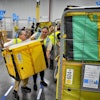DUBLIN, Ireland (AP) — Luxury tableware manufacturer Waterford Wedgwood PLC said Wednesday it is cutting 1,400 jobs worldwide, including nearly half of workers at its flagship Irish crystal plant, in part because of the weak U.S. dollar.
The Dublin-based company, which has reported five years of deepening losses and debt, said it would lay off 490 of its approximately 1,000 workers at the crystal factory in Waterford, southeast Ireland — and focus on developing the plant's status as a tourism magnet.
Waterford Wedgwood, which has a global work force of 8,000, declined to specify where it planned to cut the other 910 jobs, but said it would target ''manufacturing, administration, warehousing, distribution and other operations in high-cost countries.''
The company is a significant employer in England, Germany, Indonesia and the United States, where it employs about 800 people in sales, marketing and distribution.
John Foley, chief executive of the Waterford Crystal Ltd. division, broke the news to workers at the factory in Waterford, where the tradition of hand-cut crystal began more than two centuries ago. He said production ''at the present scale has become untenable.''
Foley cited the U.S. dollar's exceptional weakness as a key factor in slashing profits, because the United States typically accounts for half of crystal sales. But he said Ireland also had grown prohibitively expensive versus the company's increasing use of subcontractors to manufacture Waterford-brand crystal in Brazil, Germany, Hungary and Slovenia.
Company directors previously have heralded their increasing shift of production to developing countries, where operations are priced in U.S. dollars rather than the euro or similarly expensive British pound.
''The only way to secure the future of the operations in Waterford is to close the parts which are uncompetitive and to outsource these activities to lower-cost environments which can meet the quality standards of the Waterford brand,'' Foley said.
''We intend to cease production of several lines that are loss-making and focus the factory on the production of high-quality, cost-competitive products,'' he said. ''It is imperative that we continue to focus on our remaining cost-competitive capabilities to secure the future of manufacturing in Ireland, while continuing to monitor the value of the dollar.''
The value of Waterford Wedgwood shares has plunged 95 percent since the company last reported a profit in 2002 — the same year that the dollar began its descent. In 2005, the company closed another crystal plant in Ireland and a ceramics factory in England, and cut 2,300 jobs in both countries, during its last round of cost-cutting.
That clearly has not been enough. Two weeks ago, Waterford Wedgwood reported a net loss of euro57.1 million (US$83.6 million) in the April-September period, compared to a euro21.1 million loss for the same period of 2006.
Sales fell 7 percent to euro317.4 million (US$464.7 million) from euro341.4 million. Its debts grew to euro473.4 million (US$693.1 million) from euro398.2 million in September 2006.
Waterford Wedgwood shares fell 4.8 percent Wednesday to 2 euro cents (2.9 U.S. cents) amid wider losses on the Irish Stock Exchange.
Foley said a key to Waterford's future profit in Ireland would be as a tourist and shopping mecca. He said the plant's production tours and crystal showroom already attract 300,000 tourists a year, and plans to build ''an exciting retail and tourism experience'' could double the number of visitors by 2012.
Waterford Crystal traces its lineage to a factory opened in the town in 1783, although that business failed in the 1850s. The brand was revived by a Czech immigrant to Waterford, Miroslav Havel, in 1947.


















